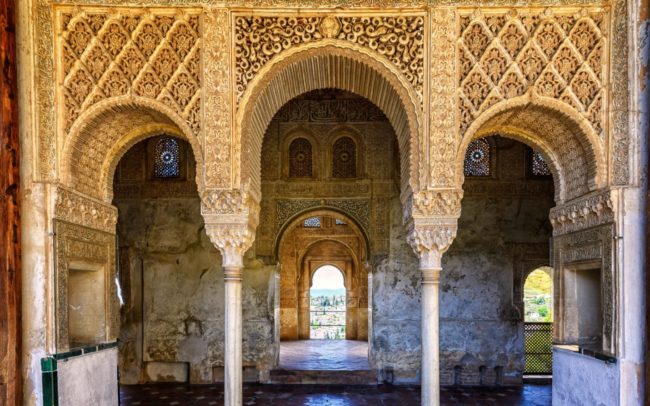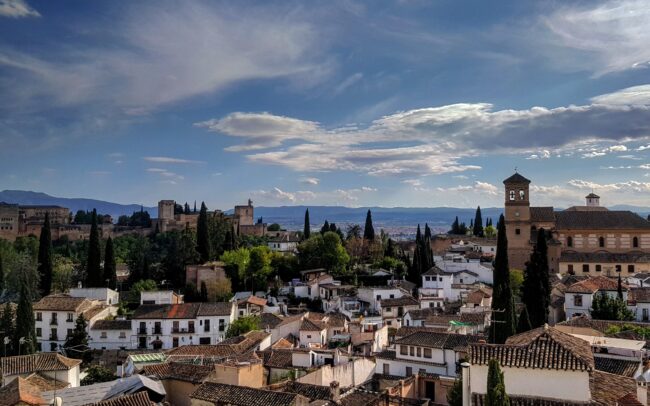Andalusia
Granada: the city below La Alhambra
Every inquisitive traveller keeps Granada in his heart, without having even visited it.
William Shakespeare
La Alhambra and Generalife Tour
First Spanish monument to be declared a UNESCO World Heritage site in 1984: the best-preserved medieval Islamic fortress, hiding a charming palace and dreamy gardens. Layers of history and stories for every taste. An absolute must-see in Spain.
Between the 13th and 15th centuries, Granada was the capital of the last Muslim kingdom in the Iberian Peninsula: the Nasrid Emirate. For 260 years, this Andalusian city flourished as a cultural and political centre of great importance. In the heart of Granada, on the hill of the Sabika, stands the majestic Alhambra, also known as “the red”. This iconic palace complex was the nucleus of Nasrid power, protected by its imposing defensive walls.
In 1492, the history of Granada took a decisive turn with the capture of the city by the Catholic Monarchs. The surrender of the last Muslim monarch, Boabdil, marked the end of Islamic rule on the peninsula. From then on, the Alhambra in Granada became a symbol of Christian victory. One of the most outstanding changes was the construction of the Palace of Carlos V, which added a new architectural style to the complex. Today, the Alhambra and the Generalife represent a unique fusion of Islamic and Renaissance art, reflecting Granada’s rich cultural history.
During the visit to this emblematic monument of Granada, we will be captivated by the beauty of the Nasrid Palaces, where light, water and geometry create spaces full of magic and spirituality. The delicate epigraphy that adorns the walls turns the Alhambra into a palace that describes itself, revealing the symbolic depth of Nasrid art.
The gardens of the Generalife, also known as Yannat al Arif, invite us to enjoy a unique sensory experience in Granada. Its gardens and fountains represent the power of water as a symbol of purity, life and spirituality.
To top the tour, we will climb the towers of the Alcazaba, the ancient military fortress. From there, the panoramic view of Granada will give us an unforgettable image of the Albayzin district, the fertile plain of Granada and the snow-capped peaks of the Sierra Nevada.
I do not know what to call this land upon which I stand. If what is beneath my feet is paradise, then what is the Alhambra? Heaven?
Lope de Vega
Albayzín and Sacromonte tour
The Albayzín, a UNESCO World Heritage neighbourhood since 1994, is the old Muslim quarter of Granada. It is located on the north hill of the Alhambra. It was founded in the 11th century by the Ziríes, the first Muslim dynasty in Granada. However, over time, and already in the Nasrid period, it had to expand to accommodate the Muslims who had fled from Christian areas.
If two neighbourhoods define Granada, they are the Albayzín and the Sacromonte. As you stroll through the area, you will discover the labyrinthine urban layout typical of Arab cities. Through the architecture, you will gain an insight into the lifestyle and customs of those who lived there. You will learn about Los Carmenes, the system of ditches and cisterns that provided the neighbourhood with its most precious resource: water.
The evolution of the city since 1492 includes various transformations carried out by the Christians. For example, churches that were once mosques and elegant Gothic or Renaissance houses that were built on the sites of the Muslims’ discreet courtyard houses.
Sacromonte is a neighbourhood where the gypsies settled in the 15th century, in cave houses, used to this day. Walk along its steep trails, and you will also learn about the origins of this ethnic group and its contribution to flamenco. This musical genre has been declared an intangible cultural heritage of humanity by UNESCO.
In Sacromonte, one can enjoy impressive views from its hidden outlooks. This visit is undoubtedly a journey back in time, offering the chance to discover narrow streets and beautiful corners that are difficult to find in other European cities because Granada is special!
Granada Essential walking tour
Granada is a diverse and dynamic city, the result of an intense history that has left its mark on it until today. The intense history of Granada is the reason why, on this visit, we will take a general tour of the most outstanding places in the historic centre, without forgetting those that tend to be outside the conventional itineraries.
The city centre was the area that changed the most after the Christian conquest. This is why it is full of art and a combination of styles. In short, it is the result of the evolution from the Muslim to the Christian world. During the tour, we will see the imposing cathedral, the second-largest in Spain, and the Royal Chapel, where the Catholic Monarchs wanted to be buried.
Alongside these two examples of Christian art, we will visit the Alcaicería, the old Muslim silk and spice market, and the Madrasa, a school for the study of Arabic and the first public university on the Iberian Peninsula. As we walk, we will also discover majestic plazas such as the Bib-Rambla and the Plaza Nueva.
The Garnata Al Yahud was the Jewish quarter of medieval Granada. This area is nowadays known as the Realejo neighbourhood. Exploring those lesser-known areas will open the door to learn about their history and evolution.
All of Granada’s highlights can be explored on foot. The mountainous structure of the city and the stairs require comfortable shoes.
The city of Granada can be visited in two days, making the combinations that best suit your interests.
We recommend taking advantage of Granada’s excellent location for excursions outside the city. Sierra Nevada, La Alpujarra or El Torcal de Antequera, as outstanding natural environments. Granada is also a good starting point for day trips to Úbeda or Baeza and for an experience around olive oil production (ideally in autumn).
If you plan a few days in Granada, please, ask us about the possibilidies of day excursions and experiences in the area!
MORE EXPERIENCES IN ANDALUCIA
Málaga & Almería tailor-made tours


